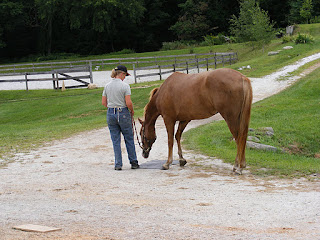I had taken Rumer out for a little walk and we were doing silly things. If she is going to be appropriate for kids, she needs to learn about silly. So we went for a walk, we stepped over logs in the woods, we got the mail from the mailbox and other things we've done before. Then when I was putting the mail in the garage, I decided she might as well learn to go odd places. I certainly took my pony odd places when I was a kid. So I invited her into the garage. The big door was closed and so I stepped into the person door. It was a bit dark in there but she bravely followed me, tiny step by tiny step. Our garage is a bit of a catch all so the recycling boxes were on one side of her, along with the hose coiled on the floor. The cot that I sleep on for foaling is stored in there, covered with plastic; various buckets, a wheelbarrow, bikes hanging from hooks in the ceiling- all were carefully and hesitantly checked out. So far I was doing no CT. I was just taking a step and letting her explore. Our winter tires were stacked in there, four to a pile each covered with a white plastic bag. I led her between the two stacks, just barely room for her to fit. I lifted up the big overhead door a couple times, but she was a bit reactive about that and I didn't want her backing into the hanging bikes such that they came crashing down on her head so we just played with the door going up and down a foot or two- then back out to the sunshine.
I asked if she wanted to jump up onto the porch. She looked like she would be fine with that but unfortunately we have no porch steps and it would have required jumping over her knee height. I didn't want her slipping on landing so instead she just investigated all the flower pots and things she could reach.
Then we came to the laundry line. Again, she followed me to it and sniffed the clean laundry hanging from it, but when I asked her to follow me under it, she said no thank you. First I asked just the way I had done all afternoon- I walked forward a step and waited to see if she would follow, no pressure. The line was high enough that she wouldn't guillotine herself on it but low enough that the socks were going to drape over her back as she walked under. But she was concerned enough that her head was up and the socks were at face height. I put the tiniest bit of pressure on the rope- no more than a suggestion. She still thought it was not safe. Considering how many things she had done already even when she was worried, I knew we had reached a new level of concern.
So I put out a fist. Oh- there's a target, she said, and took a little step forward to target my fist- CT. I stepped back a little and did it again. It was as if the laundry had magically disappeared. Two touches to my fist and she was under the laundry line without dislodging a sock.
My only reasoning is that all her life, targeting has been a fun and successful thing to do. It's never failed her. If it was as easy as targeting my fist, she lost all fear and was able to be successful.
















